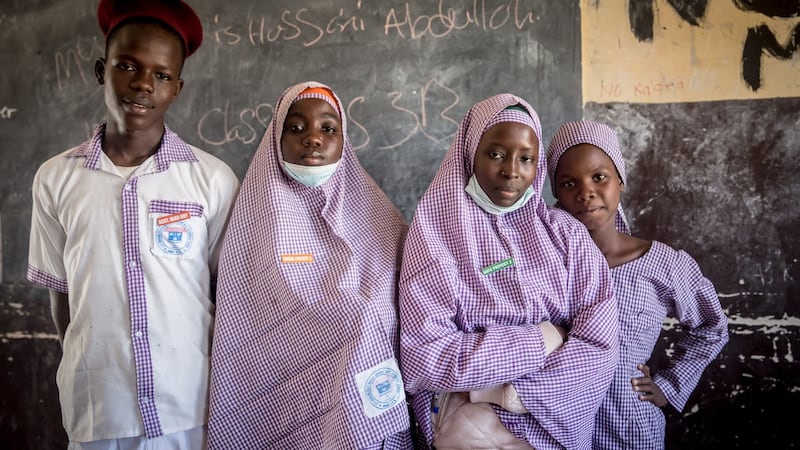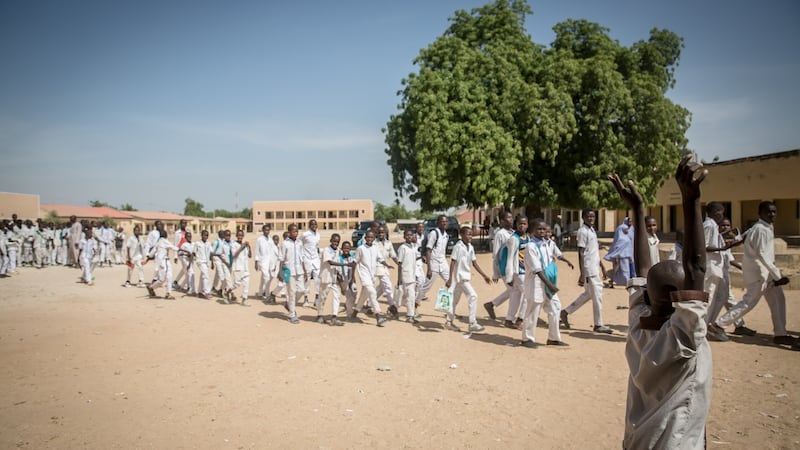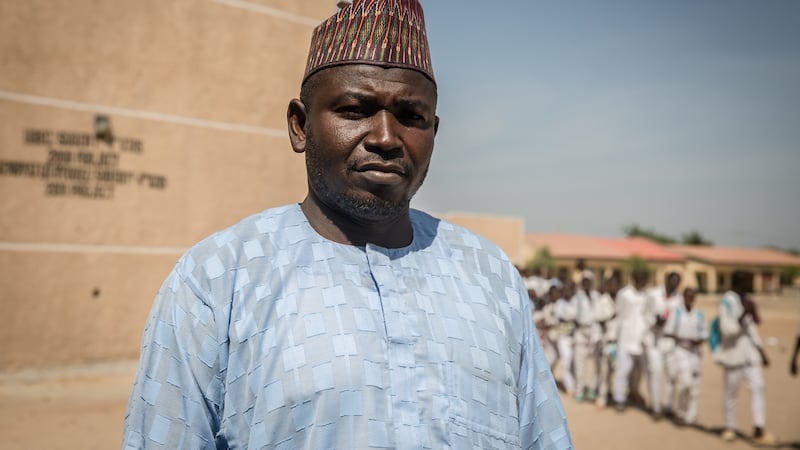Head teacher Sani Garba Mohammed stands in front of a blackboard reading “R data processing” in the El Ansar Islamiya school in Maiduguri, northeast Nigeria. These are notes from a computer class, he explains, even though his school of more than 400 students has no computers. “We learn theory,” Mohammed laughs.
He has bigger problems to deal with. The school charges fees of 4,000 naira (€8.46) a term but he estimates that only 30 per cent of students pay it. Teachers in Nigeria get “respect but no money” and purchasing basic supplies for the school is a struggle, he says.
But he counts his blessings too, among them the fact that – though there are still sporadic attacks close by by Islamist militant group Boko Haram – the security situation has improved inside his city's limits and he feels less of a target than teachers would have in the past.
Northeast Nigeria is likely one of the most dangerous places in the world to attend school, and still teachers lead lessons and the students come. More than one million students have been forced out of education in the region during a 13-year-old insurgency that has displaced millions and killed hundreds of thousands of people, including more than 2,200 teachers, according to the UN children's agency, Unicef.

At least 802 schools have been closed by the conflict, with 497 classrooms listed as destroyed and another 1,392 damaged. Some schools have been turned into camps for displaced people.
Compounding this trauma, in recent years school kidnappings have become much more common.
The abduction of 276 schoolgirls by Boko Haram – whose name roughly translates as “Western Education is Forbidden” – from the northeast town of Chibok in April 2014 by the insurgent group sparked an online social media campaign, #BringBackOurGirls, which received worldwide attention.
Ransoms
Over the following years, the Nigerian government swapped prisoners and paid millions of dollars to secure the release of some of the girls – though more 100 of the abductees are now dead or still held by the militant group.
Kidnappings have long targeted relatives of the wealthy or famous in Nigeria, but in the years since the Chibok abductions, school kidnappings have become a lucrative business, with the perpetrators – ranging from insurgents to bandits – demanding ransoms of hundreds of thousands of euro, even when kidnapping poor children.

A report carried out by SBM Intelligence, a Nigerian intelligence platform, said that at least $18 million was paid to Nigerian kidnappers between June 2011 and March 2020.
A $30 million Safe Schools Initiative, spearheaded after the Chibok kidnappings by former British prime minister Gordon Brown and supported by the UK's Department for International Development, UN agencies, private business leaders and the Nigerian government, saw promises to protect 500 schools in the northeast, but last year the BBC revealed that almost nothing had come from it.
By November last year, Unicef said there had been at least 1,440 students abducted in Nigeria and 25 attacks on schools in 2021 alone. In northeast Nigeria specifically, Unicef said thousands of children in the region had been killed, maimed, abducted, displaced, and experienced multiple violations of their human rights because of the ongoing conflict.
"Nigerian children – whether they are the direct targets of violence or collateral victims of conflict – are caught up in the ongoing insecurity we are seeing across the country. This is unacceptable," said Phuong T Nguyen, the head of Unicef''s Maiduguri field office.
Added to these threats are issues related to poverty, a lack of support, the need to find food and other obstacles which mean that only around half of children in northern Nigeria attend school, according to Unicef.
Drinking water
Some 850 students attend Maiduguri’s 777 Junior Secondary School, 380 of them girls. There are just 13 staff, as well as four volunteer teachers who come in three days a week. “There are not enough,” says Hajja Aishatu Yuguda, the school’s principal, sitting behind a desk with boxes of chalk and Unicef-branded notebooks on it. “The teachers have to combine subjects and classes and teach two [classes] at a time.”

The school is unable provide enough drinking water to students, she adds. Some of the students are from families displaced by the conflict, or orphans taken in by relatives, and they turn up hungry or not properly clothed. But they clearly want to learn.
The school was closed for seven months at the beginning of the Covid-19 pandemic, during which time most students did not have access to TVs or radios for remote learning, but now they're catching up, she says. Some now receive free uniforms, notebooks and pencils from organisations such as Plan International and Unicef.
In one of the classrooms, students speak about their experiences.
“They’ve giving us knowledge and things we should know for the future,” says Hyeladzira Balami (13), whose favourite class is English. “I want to be a lawyer. To decide what’s right and wrong and cast judgement on corruption. The leaders we have are corrupt, if they are found doing something they pay money and get away but I wouldn’t be corrupt, I’d pass fair judgement.”
Maryam Ali, a 16-year-old with seven siblings, wants to be a doctor to help the sick. “I like school because I’m learning,” she says. “If I didn’t learn I’d be dull and dirty.”
“Because of our circumstances people want access to education, they want to get knowledge,” she says, when asked why so many young people here seem to prioritise schooling. “A lack of education can push people into lots of things including insurgency, drug addiction, prostitution.”

Assistant head boy Mikail Abubakar (14), moved to the area six years ago, after his family fled conflict 70km away in Bama. He dreams of studying physics, joining the navy and travelling to Dubai. "I have seen pictures on the internet, it is very beautiful."
In his class just three could afford to buy textbooks, and they keep them to themselves, he says. When Abubakar goes home, his older brother assists him with homework. His parents sewed his uniform.
Hunger
In government schools, overcrowding can be extreme. More than 18,000 students are enrolled in the Moduganari Primary and Secondary government schools in Maiduguri, according to teachers – and they share one premises. There are plumbing issues and just 12 toilets. Many students show up hungry, begging for food from others in their classes.
"The nearby catchment area has many displaced people, which has increased the population," says Baba Ganae A'aj, head teacher of the primary school.

Only about 20 percent of parents can afford to buy educational supplies for their children; others are provided by charities. “Some children come from vulnerable families and they don’t have food to eat, the parents go begging to find something to eat, they don’t bring food to school,” she says. Other children leave school to go straight to work at jobs like carpentry, welding, or repairing generators. In the afternoon, more young people, who have dropped out of the formal school system, come by to do classes.
One of those working is Usman, a 14-year-old who says he loves reading, writing and learning about the best ways to cultivate crops and rear animals. After school each day he roams the streets looking for people who need their shoes repaired. He uses the money to buy uniforms and books for his younger siblings.
Danec Andrew (13) says her favourite subject is science, but she says it’s hard to study when her classroom doesn’t have enough desks for them to sit at.
Because of the lack of teachers, students are recruited as prefects to try to get others to behave. Hadiza Ibrahim (14) says it can be “stressful” ordering around other students as “the children are so many”. Some of the prefects have sticks with rope hanging off them. “When you use the cane they listen,” says Ibrahim.
Teachers in the schools are paid 13,000-15,000 naira (€27 to €32) a month by the government. Plan International also gives some untrained teachers a stipend.
One of these charity-funded – or “volunteer” – teachers, Falmata Abdulkadir Alkali, invites us to imagine teaching a group of 189 five-year-olds writing, maths or English. The lack of running water and sanitation means that disease and illness can spread quickly, and there are other interruptions too. “The students that are hungry disturb the other students,” she says.
“Some are coming barefooted, without sandals, their uniforms have tears,” says Rifkatu Jacop, another so-called “volunteer” teacher. “Sometimes you pity them and give them money to buy food.”
“You cannot mark their books, there are too many,” says Dunya Mgwamdai, who posited that reducing the numbers in a classroom to “just” 50 students would make things a lot more manageable. “They would hear you, they would co-operate with you.”











